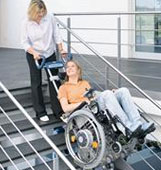|
|

|
Stair Climbers
For anyone facing mobility problems that require the use of wheelchairs, possibly the greatest challenge is the amount of steps and stairs that must be faced both in public spaces and at homes. Even if one’s own home and most public buildings are adapted with elevators and ramps, the disabled person still has its mobility greatly reduced – a stair climber can make it possible to visit friends and public venues, participating entirely in a full social life. Roughly two million people in the United States use wheelchairs at the moment, making this a sound investment for public buildings who suffer from accessibility design problems.
Stair climbers operate through powerful lifting systems feeding from rechargeable batteries, with two sets of differently sized wheels that grip over the steps and terrain obstacles to overcome them when the user’s weight shifts over the balancing system.
Stair Climber Designs:
Essentially, stair climbers are available in two distinct designs: a standalone stair climber with its own chair, or one that is designed to have the user’s wheelchair attached to the climber.
For the wheelchair user to be able to operate the stair climber on his or her own, mobility of at least one hand and a certain dexterity are required, something that can be accessed by the occupational therapist. If the user doesn’t possess such ease of mobility, all stair climbers possess back handles that allow an assistant to pull the person up.
All stair climbers available have the user face downstairs whether going up or down the decline, and therefore requiring a good amount of foresight and mental agility to evaluate paths and possible obstacles for a safe use, if alone.
Some stair climbers, like the iBot allow for constant use, which saves the disabled person from having the climber attached when needed – and depending on one’s situation, that might be too often. Having the mechanism permanently has other conveniences, such as being able to overcome all sorts of terrain obstacles and the option to perch the chair on two wheels to elevate the user, making it possible to reach higher shelves and objects, and have eye to eye conversations.
Stair Climber Uses:
The most flexible stair climber designs are either foldable or can be disassembled into parts easily, so that they can be transported in a car trunk – after all, if bought for private use the point will be to take advantage from them in places that haven’t been reconditioned to solve wheelchair obstacles. This addition to a wheelchair can truly free the user to visit places that would otherwise be impossible and avoiding the often humiliating need for being carried.
Public venues like schools, civic centers and hospitals can benefit greatly from the use of stair climbers, particularly in the case of old buildings. The climbers are rather lightweight and can be transported easily to relocate visitors with reduced mobility inside and out from the structure. Some models are thought for medical emergencies and use an Integrated Transportation Safety System to reduce transfers between equipments – the patient can be wheeled over chairs and the chair locked onto the ambulance’s floor to be moved to the hospital.
↑ Top
|
|